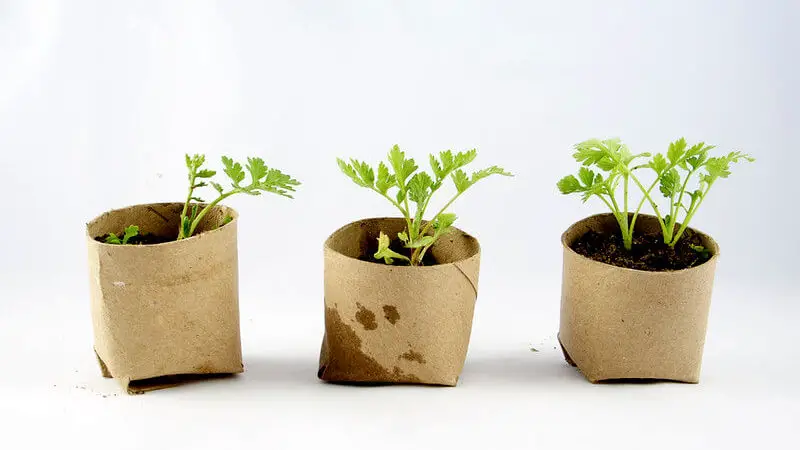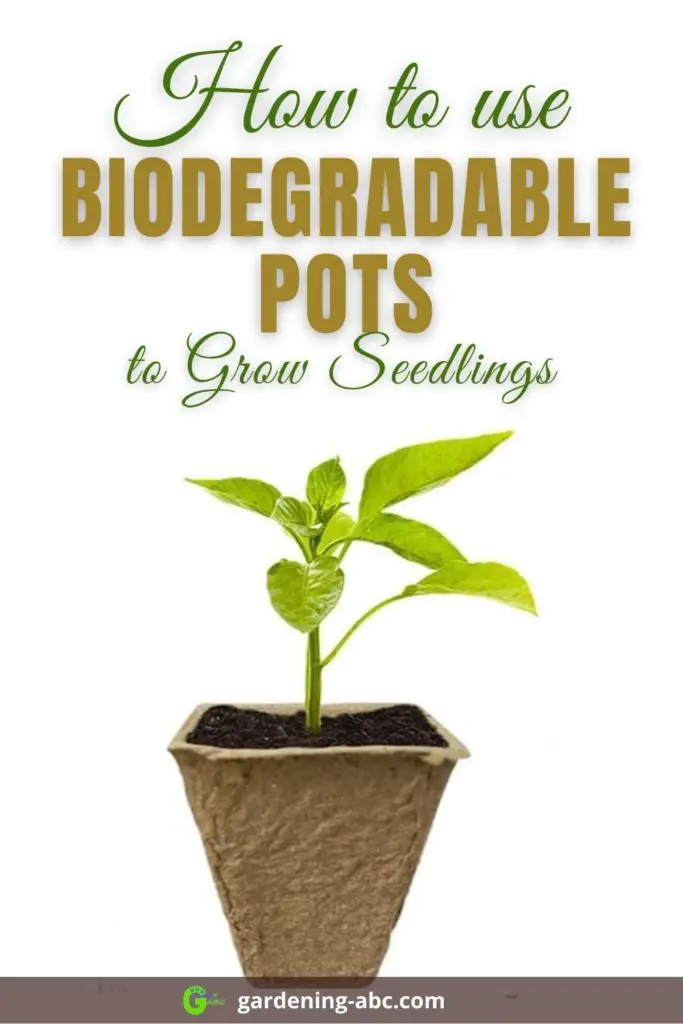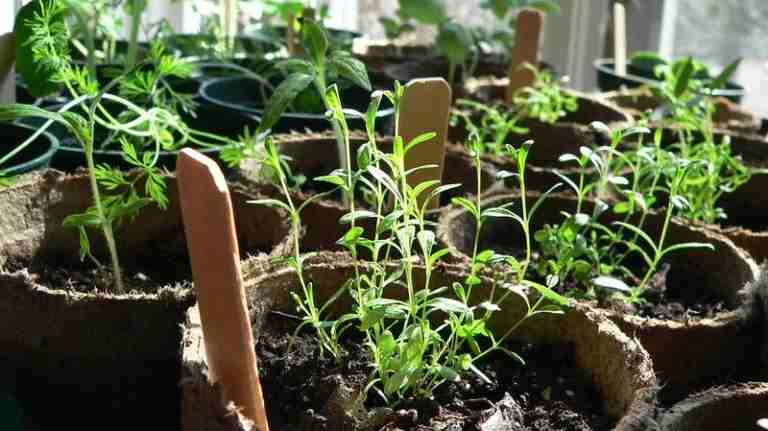We use affiliate links to run our site. When you buy through links on our site, we may earn an affiliate commission, without any added cost to you. Learn more
What Are Biodegradable Pots?
Biodegradable pots are special types of containers that you can use to grow seedlings and plants. What makes these pots special is they break down naturally in the soil after a certain time and become a part of that soil.
Most of us probably use plastic pots to grow seedlings and plants but with biodegradable pots around, you can say goodbye to plastic and opt for a more nature-friendly option to grow plants. It will also increase the success rate of plant survival by reducing transplant shock.
Feeling interested? Let’s dig more about Biodegradable pots and their uses.
Different Types of Biodegradable Pots:
There are different types of biodegradable pots that you can use to grow plants. To make things simple, here are 6 of the best biodegradable pots and their pros and cons.
Bamboo Pots:
These pots are made from bamboo pulp and are by far the strongest of all biodegradable pots.
Bamboo pots look and feel somewhat like plastic, and can stay intact for up to 3-4 years before starting to break down.
After the use, you can just get them composted. They are slow to break down and can take about 6-12 months.
Pros:
- They look more like conventional planter with a great range of color and design.
- You can easily grow plants in bamboo pots on the windowsill or in indoor gardens.
Cons:
- The downside of these pots are you cannot use bamboo pots for direct planting into the soil. As they have a longer lifespan they won’t able to give enough space for the plant to expand their roots.
Coir and Peat Pots:

These pots are made either from the coco coir or peat moss. In both cases, dried fibers are compressed and used to make these pots. Coir and peat pots are available in various sizes and are excellent options for growing seedlings.
If you are growing plants in fiber pots remember they do dry out quickly so keep them well watered. Keep them always from the hot sun or drying winds otherwise, they will wilt within a day.
In nurseries, it is a general practice to water the plants daily.
Pros:
- Coir and peat pots break up quite quickly. So you can easily grow seedlings and plant them directly into the soil.
- This way the plants can be transplanted without any root disturbance. Within two months these pots will degrade fully and become a part of the soil.
- During these two months, plant roots can easily grow through the fibers so the growth of the plant is not disturbed by any means.
Cons:
- As they degenerate quickly you can not use them like bamboo pots to grow a full plant. Their sole purpose is to grow seedlings and transplant them without disturbing the roots.
Peat Pallets:
Peat pallets are more or less the same as peat pots only difference is that they are not in the shape of pots. They are made up of compressed coir or peat. Once you add water they will expand in size.
Pros:
- You can grow seeds in these pallets and later when got to the optimal sizes plant the pallet along with the seedlings in the soil without disturbing the root by any means.
Cons:
- As they are only available in limited sizes these are more suitable for sowing seeds.
- As the pallets don’t have any hard outer casing, they can dry out very easily. To avoid this problem some special trays are often molded to place the pallets.
Paper Pots:
You can use newspapers or magazines to make paper pots and grow seedlings in them.
Pros:
- They are very cheap and do a great job of growing transplants.
- Like coir pots, they also degrade very quickly when in the soil.
Cons:
- They are not sturdy enough to grow plants and can only be used to transplant seedlings.
Biodegradable Plastic Pots:
These pots are made up of a special kind of plastic that breaks down naturally. They look like any regular plastic pots and you can use them to grow plants.
Once you decide to dispose them off, just cut the pot into pieces and use them as compost ingredients. It would take 3-4 years to break down completely.
Cons:
- One of the main problems of using these pots is the plant becomes root-bound. The roots grow into a dense ball and start to resemble the shape of the pot.
- This can actually affect your plant’s health as the roots have very little access to nutrients.
Cardboard Tubes:

Once you are finished with your toilet rolls you can use the inner cardboard tubes to grow plants. They make very good biodegradable pots. You can use them to sow crops like sweetcorn, leeks, or beans.
Pros:
- They are very cheap.
- They are easy to recycle.
- Takes very little space.
- Easy to use.
Cons:
- They absorb water so you need to be careful the plant doesn’t die out of thirst.
- They are only suitable for seeds that germinate very quickly because it doesn’t take long for the pots to break down.
Biodegradable Pots vs Conventional Pots:
Biodegradable pots may not be as durable as conventional pots like terracotta or plastic pots but they have some inherent advantages.
Here are the main 5 benefits of using biodegradable pots:
- They are nature friendly.
- They make the transplanting process very easy.
- No root disturbance for the plants.
- No cleaning of the pots after use.
- You can also use household items to create the pots.
How to Use Biodegradable Coco Coir Pots:
- Before planting dip the pot with the roots into a bucket of water so it is fully wet. For succulents, you might not need to dip the pot in water.
- Tear off the top half-inch of the coir pot. It could wick water away from the soil surface and limit the amount of water that reaches the plant’s roots.
- Then tear off the bottom of the pot, too, unless roots have already fully penetrated it. This will make it easier for the seedling to take root and access nutrients and water from the ground.
- While planting, dig a hole and plant the pot into the soil. When refilling the planting hole, gently press the soil back into the hole, leaving no empty spaces, or air pockets, underground.
- Water thoroughly after planting.
You might have used plastic pots and module trays for sowing seeds and transplanting for years. But with the growing importance of going organic, biodegradable pots are definitely worth a try.
There is a wide range of products that are easily available in the market. Give them a look and see if they suit your need.
Like the post? Don’t forget to PIN IT

Amazon and the Amazon logo are trademarks of Amazon.com, Inc, or its affiliates.

Hi there! My name is Prasenjit and I’m an avid gardener and someone who has grown a passion for growing plants. From my hands-on experience, I have learned what works and what doesn’t. Here I share everything I have learned.
